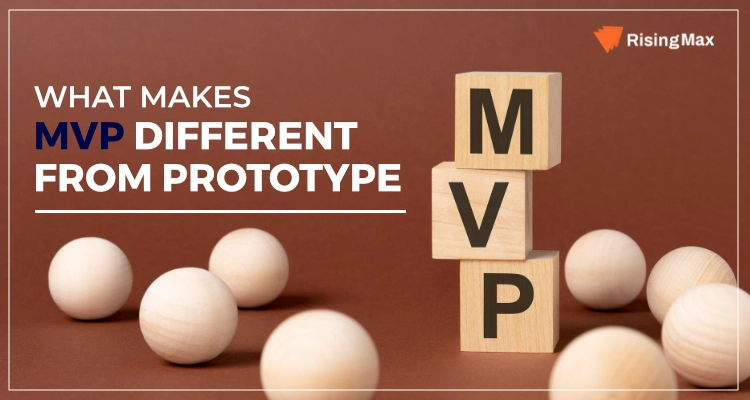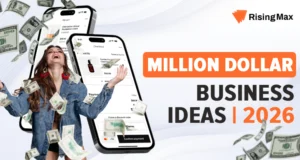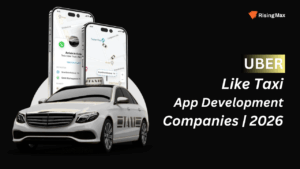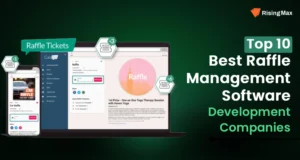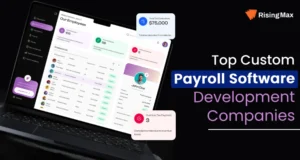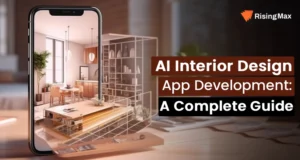Developing any product or project should involve two essential stages to determine whether developing the product is reliable and whether it will work perfectly in the marketplace; Minimum Viable Product (MVP) and Prototype. While both play crucial roles in the product development lifecycle, they serve distinct purposes and exhibit notable differences.
An MVP is the preliminary version of a product that encompasses its core features, designed to gather user feedback and validate the product’s viability in the market. On the other hand, a Prototype is a preliminary model created to visualize and test specific design elements, functionality, and user interactions.
This article will help you understand the difference between MVP and Prototype and the goals, scope, and how you can create MVP or prototype.

What Is Prototype?
A prototype of an application is a preliminary, simplified version that demonstrates key design and functionality aspects. It is a tangible representation of the final product, showcasing user interfaces, interactions, and basic features. Prototypes allow stakeholders to visualize the user experience, identify design flaws, and gather feedback early in development.
They facilitate communication between designers, developers, and clients, helping to refine concepts before full-scale development begins. While prototypes may lack the final application’s full functionality and backend integration, they are crucial in refining design decisions and ensuring the product aligns with user needs and expectations.
Also Read: Blockchain Prototype Development
What Is MVP Of Application?
A Minimum Viable Product (MVP) is the initial version of a product that contains essential features for solving a specific problem. It’s deliberately simplified to swiftly deliver core functionality to users, aiming to validate the product’s viability and gather user feedback. MVPs enable efficient resource allocation by focusing on key features, reducing development time, and allowing iterative improvements based on user input. This approach helps businesses test hypotheses, minimize risks, and ensure that further development aligns with user needs, fostering a more effective and user-centred product evolution.
4 Major Goals Of Developing Prototype Of The Application
Visualizing Concepts
Prototypes allow stakeholders to visualize and understand the design and functionality of a product early in the development process. They provide a tangible representation that helps bridge the gap between abstract ideas and concrete implementation, aiding discussions and decision-making.
Identifying Design Flaws
By creating a working model of the product’s user interface and interactions, prototypes facilitate the early identification of design flaws and usability issues. This allows designers to refine the user experience and make necessary adjustments before investing significant resources in full development.
Gathering User Feedback
Prototypes provide a platform for user engagement, enabling testers to interact with the product’s interface and features. This feedback loop helps software developers understand user preferences, pain points, and suggestions, leading to iterative improvements that result in a more user-centric final product.
Communication and Collaboration
Prototypes are a common reference point for cross-functional teams, including designers, developers, and clients. They enhance communication by visually demonstrating the intended product direction, reducing misunderstandings, and fostering collaborative decision-making throughout the development lifecycle.
No matter how complex your project development needs are, our qualified team will get the job done within your budget.
4 Major Goals Of Developing MVP Of The Application
Rapid Validation
The primary goal of a Minimum Viable Product (MVP) is to validate a product concept’s feasibility and market demand swiftly. By delivering a basic version with essential features, MVPs enable early user testing and feedback collection, confirming whether the product solves a real problem and aligns with user needs.
Resource Efficiency
MVPs focus on core functionalities, reducing development time and costs. This efficient use of resources allows businesses to test hypotheses with minimal investment, avoiding unnecessary complexities and ensuring that real-world insights guide further development.
Iterative Evolution
MVPs encourage iterative development cycles based on user feedback. This approach enables gradual enhancements, with subsequent versions building upon the foundation of the initial MVP. By incorporating user input and adapting features, MVPs evolve into more refined and effective products.
Market Entry and Learning
MVPs facilitate early entry into the market, allowing businesses to gauge user reactions and adapt to market dynamics. This process encourages continuous learning, helping companies refine their strategies, tailor offerings, and pivot if necessary while gathering invaluable insights that contribute to the product’s long-term success.
What Is The Scope Of MVP?
The scope of a Minimum Viable Product (MVP) is deliberately limited to encompass only the most essential features required to address a specific problem or need. It omits non-essential functionalities and intricacies, focusing solely on delivering a functional core. This narrow scope enables rapid development and testing, allowing quick validation of the product’s viability and user feedback collection. As a result, the MVP serves as a starting point, providing a foundation for iterative improvements while efficiently utilizing resources to align with user requirements and market demands.
What Is The Scope Of Prototype
The scope of a prototype is to visualize and demonstrate a product’s key design and functionality aspects. It aims to present a tangible model showcasing user interfaces, interactions, and basic features. While not fully functional like the end product, a prototype helps stakeholders understand the concept, identify design flaws, and gather feedback early in development. Its focus is clarifying the product’s look and feel, facilitating team communication, and refining design decisions before moving into full-scale development.
Difference Between MVP and Prototype
| Aspect | Minimum Viable Product (MVP) | Prototype |
|---|---|---|
| Purpose | Validate product viability and user demand | Visualize design elements and interactions |
| Focus | Core features for solving a problem | Design and functionality visualization |
| Functionality | Basic, functional features | Limited or simulated functionality |
| Development Stage | Iterative product development | Early design and concept exploration |
| User Interaction | Real user interaction and testing | Simulated user interaction for feedback |
| Complexity | Simplified but delivers value | Varied, depending on the design focus |
| Resources | Efficient resource allocation | May involve significant design efforts |
| Timeline | Short development cycles | Typically precedes MVP development |
| Feedback Incorporation | Drives iteration and improvements | Shapes design decisions before development |
| Goal | Market validation and user feedback | Design validation and refining concepts |
How To Create An Prototype?
Creating a prototype for an application involves several key steps to visualize its design and functionality effectively. Here’s a simplified guide in five steps:
Define Objectives and Scope
Clearly outline the purpose of the prototype and the specific features you intend to showcase. Define the scope to ensure you focus on the most critical aspects of the application.
Sketch Wireframes or Mockups
Create rough sketches or digital wireframes that outline the layout and placement of various elements on the application’s screens. This provides a basic visual representation of how users interact with the interface.
Select Prototyping Tools
Choose prototyping tools that suit your expertise level and the project’s complexity. These tools can range from simple paper and pen for low-fidelity prototypes to more advanced software like Adobe XD, Sketch, Figma, or InVision for high-fidelity interactive prototypes.
Build Interactive Prototype
Use the selected tool to transform your wireframes into an interactive prototype. Add clickable buttons, navigation, and basic interactions to mimic user flow and demonstrate how different screens connect and function.
Test and Gather Feedback
Share the interactive prototype with target users, stakeholders, or potential customers. Collect their feedback on the design, usability, and functionality. Use this feedback to refine the prototype, make necessary adjustments, and iterate on the design.
How To Create An MVP of Application?
Developing a Minimum Viable Product (MVP) for an application involves crafting a functional version with essential features to validate its viability. Here’s a concise guide in five steps:
Identify Core Features
Determine the fundamental features necessary to address the primary problem or need. Focus on functionalities that are crucial for users to interact with and experience the basic value of the application.
Create a Simplified Version
Develop a streamlined version of the application that includes only the core features. Keep the design simple and user-friendly, avoiding unnecessary complexities that might delay development.
Build Functional Prototypes
Develop prototypes for each core feature, ensuring they work as intended. These prototypes don’t need to be polished; they should demonstrate functionality and interactions effectively.
User Testing and Feedback
Provide the MVP to a group of target users for testing. Gather their feedback to assess the application’s usability and identify any issues or improvements. This helps refine the product based on real-world user experiences.
Iterate and Enhance
Incorporate user feedback and insights into the MVP. Iterate on the design, functionality, and user experience, gradually adding refinements based on the feedback received. This iterative process ensures the product aligns with user needs and expectations.
Difference Between Prototype And MVP
The difference between Prototype and MVP is a distinct concept in the product development process. An MVP is the initial version of a product with essential features aimed at validating its viability and collecting user feedback. Its focus is on delivering core functionality that solves a specific problem, with the goal of efficiently entering the market to gather real-world insights. An MVP is a foundation for iterative improvements based on user responses, ultimately leading to a refined product.
Conversely, a Prototype is a preliminary model created to visualize design elements, user interactions, and basic functionalities. It aids in clarifying the product’s look and feel, identifying design flaws, and gathering feedback early in development. Prototypes provide a tangible representation that facilitates communication among cross-functional teams and stakeholders, helping to refine design decisions before full-scale development.
While an MVP aims at market validation and user feedback, a Prototype is primarily concerned with design validation and visualization to ensure the final product meets user needs and expectations.
Certainly, here’s a generic description of MVP and prototype development services that a company might offer:
Also Read: CMS Development Company
Our Prototype & MVP Development Services
Prototype Development Services
Our prototype development services enable clients to visualize their product ideas and concepts before investing in full-scale development. We transform abstract ideas into tangible models, creating prototypes showcasing user interfaces, interactions, and design elements.
We clearly represent the product’s look and feel through wireframes, mockups, and interactive simulations. Our prototypes facilitate early-stage testing and stakeholder collaboration, allowing for the identification of design flaws and refinements. With a focus on enhancing team communication, our prototype development process helps clients align their vision and refine their design decisions before moving into full production.
MVP Development Services
Our MVP development services are designed to help startups and businesses quickly validate their product concepts and gather user feedback. We collaborate closely with clients to identify the core features for solving their target audience’s pain points. Our team of experienced developers and designers then crafts a streamlined product that focuses on delivering these key functionalities.
By leveraging rapid development methodologies, we ensure a swift turnaround time, allowing clients to enter the market with a functional product. Through continuous iterations and user testing, we refine the MVP based on real-world insights, enabling our clients to make informed decisions about the product’s direction and features.
Conclusion
We hope you know the difference between MVP and Prototype lies at the core of effective product development. While both serve as invaluable tools, they fulfil distinct roles that contribute to the success of a product.
An MVP is the practical realization of a product’s essential features, strategically designed to validate its viability and gather real-world user feedback swiftly. By focusing on delivering core functionalities, an MVP serves as the initial step toward market entry, risk mitigation, and iterative evolution.
On the other hand, a Prototype serves as a creative canvas for design exploration and concept visualization. It provides a tangible representation of user interfaces, interactions, and design elements, aiding in identifying flaws, facilitating communication, and refining design decisions before full-scale development.
An MVP emphasizes real-world validation and user-driven refinement, while a Prototype accentuates design visualization and iterative ideation. The synergy between these two approaches, each with its unique purpose, paves the way for informed decision-making, efficient resource allocation, and creating products that genuinely resonate with end-users.

